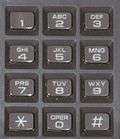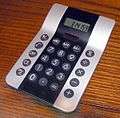Keypad
A keypad is a set of buttons arranged in a block or "pad" which bear digits, symbols or alphabetical letters. Pads mostly containing numbers are called a numeric keypad. Numeric keypads are found on alphanumeric keyboards and on other devices which require mainly numeric input such as calculators, push-button telephones, vending machines, ATMs, Point of Sale devices, combination locks, and digital door locks. Many devices follow the E.161 standard for their arrangement.

Uses and functions
A computer keyboard usually has a small numeric keypad on the side, in addition to the other number keys on the top, but with a calculator-style arrangement of buttons that allow more efficient entry of numerical data. This number pad (commonly abbreviated to "numpad") is usually positioned on the right side of the keyboard because most people are right-handed.
Many laptop computers have special function keys which turn part of the alphabetical keyboard into a numerical keypad as there is insufficient space to allow a separate keypad to be built into the laptop's chassis. Separate external plug-in keypads can be purchased.
Keypads for the entry of PINs and for product selection appear on many devices including ATMs, vending machines, Point of Sale payment devices, time clocks, combination locks and digital door locks.
Key layout
The first key-activated mechanical calculators and many cash registers used "parallel" keys with one column of 0 to 9 for each position the machine could use. A smaller, 10-key input first started on the Standard Adding Machine in 1901.[1] The calculator had the digit keys arranged in one row, with zero on the left, and 9 on the right. The modern four-row arrangement debuted with the Sundstrand Adding Machine in 1911.[2]
There is no standard for the layout of the four arithmetic operations, the decimal point, equal sign or other more advanced mathematical functions on the keypad of a calculator.
The invention of the push-button telephone keypad is attributed to John E. Karlin, an industrial psychologist at Bell Labs in Murray Hill, NJ.[3][4] On a telephone keypad, the numbers 1 through 9 are arranged from left to right, top to bottom with 0 in a row below 789 and in the center. Telephone keypads also have the special buttons labelled * (star) and # (octothorpe, number sign, "pound", "hex" or "hash") on either side of the zero key. The keys on a telephone may also bear letters which have had several auxiliary uses, such as remembering area codes or whole telephone numbers.
Origin of the order difference
Although calculator keypads pre-date telephone keypads by nearly thirty years, the top-to-bottom order for telephones was the result of research studies conducted by a Bell Labs Human Factors group led by John Karlin. They tested a variety of layouts including a Facit like the two-row arrangement, buttons in a circle, buttons in an arc, and rows of three buttons.[3] The definitive study was published in 1960: "Human Factor Engineering Studies of the Design and Use of Pushbutton Telephone Sets" by R. L. Deininger.[5][6] This study concluded that the adopted layout was best.
Despite the conclusions obtained in the study, there are several popular theories and folk histories explaining the inverse order of telephone and calculator keypads.
- One popular theory suggests that the reason is similar to that given for the QWERTY layout, the unfamiliar ordering slowed users to accommodate the slow switches of the late 1950s and early 1960s.[7]
- Another explanation proposed is that at the time of the introduction of the telephone keypad, telephone numbers in the U.S. where commonly given out using alphabetical characters for the first two digits. Thus 555-1234 would be given out as KL5-1234. These alpha sequences were mapped to words. "27" was given out as "CRestview", "26" as "ATwood", etc. By placing the "1" key in the upper left, the alphabet was arranged in the normal left-to-right descending order for English characters. Additionally, on a rotary telephone, the "1" hole was at the top, albeit at the top right.
See also
- Keyboard (computing)
- Telephone keypad
- Push-button telephone
- Silicone rubber keypad
- Numeric keypad
- Keyboard technology
- Mobile phone
- Digital door lock
- Arrow keys
References
- "William and Hubert Hopkins machines". Retrieved 18 July 2017.
- "Sundstrand Adding Machine - Underwood Sundstrand". Retrieved 18 July 2017.
- Fox, Margalit (February 8, 2013). "John E. Karlin, Who Led the Way to All-Digit Dialing, Dies at 94". The New York Times. Retrieved February 9, 2013.
- "Monmouth man, inventor of touch-tone keypad, dies at 94". The Star-Ledger. February 9, 2013. Archived from the original on February 13, 2013. Retrieved 2013-02-09.
- Deininger, R. L. (July 1960). "Human Factor Engineering Studies of the Design and Use of Pushbutton Telephone Sets" (PDF). The Bell System Technical Journal (July, 1960): 995. Archived from the original (PDF) on 2014-01-24. Retrieved 7 February 2014.
- Feldman, Dave (1987). Why Do Clocks Run Clockwise. New York: Harper & Row.
- "Why is the keypad arrangement different for a telephone and a calculator?". How Stuff Works. Retrieved 7 February 2014.
External links
| Look up keypad in Wiktionary, the free dictionary. |
